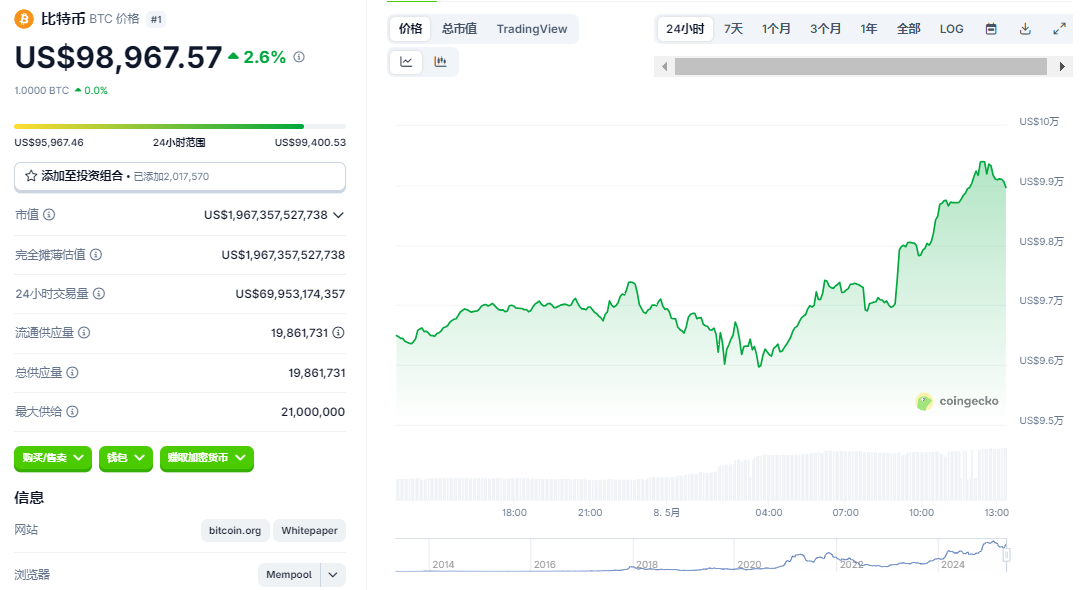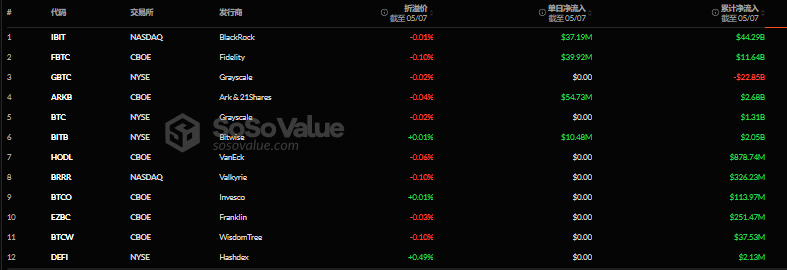
May 8, 2025, Thursday —— Under the resonance of multiple macro and market variables, Bitcoin (BTC) broke through $99,000 early this morning, with a 24-hour increase of 2.55%. Ethereum (ETH) and Solana (SOL) and other mainstream cryptocurrencies also rose simultaneously. This breakthrough is only 5 months away from Bitcoin's first historical high of $100,000 on December 5, 2024, while the current market is facing multiple complex situations including Federal Reserve policies, geopolitical conflicts, institutional fund inflows, and short selling.
I. Market Dynamics: ETF Funds Continue Flowing In, Cryptocurrencies Rise Across the Board

According to SoSoValue data, on May 7 Eastern Time, Bitcoin spot ETF had a single-day net inflow of $142 million, with none of the 12 ETFs experiencing capital outflows.
Among them, ARK Invest's ARKB led with a net inflow of $54.726 million, followed by Fidelity's FBTC with $39.919 million. As of May 8, the total net asset value of Bitcoin spot ETFs reached $11.271 billion, accounting for 5.86% of BTC's total market value, with a cumulative net inflow exceeding $40.719 billion.
Meanwhile, Bitcoin price broke through $99,000 on the morning of May 8, reaching a high of $99,500, creating a new high since December 2024. Ethereum broke through $1,900 (24-hour increase of 4%), Solana (SOL) stood at $151 (increase of 3.3%), with the overall market showing a rising trend.
II. Macro Variables: Federal Reserve "Stays Put", Rate Cut Expectations Delayed
On May 7, the Federal Reserve announced maintaining the federal funds rate target range at 4.25%-4.5%, in line with market expectations. Chairman Powell emphasized a "wait-and-see" stance at the press conference, stating that current inflation and employment data still have uncertainties, and rate cuts require more economic weakness signals. The market's probability of a July rate cut dropped from earlier 65% to 57%, while the probability of maintaining rates in June is as high as 80%.
Despite the hawkish Fed resolution, the market reaction remained relatively stable. Analysts noted that this result was already anticipated, and investors are more focused on subsequent economic data and geopolitical risks. Powell's mentioned "dual mandate" (inflation and employment balance) has not yet made progress, suggesting monetary policy is unlikely to turn in the short term.
III. Geopolitical Conflict: India-Pakistan Tension Becomes a New Variable
Since early May, tensions have escalated at the India-Pakistan border, with Pakistan claiming to have shot down 5 Indian fighter jets (denied by India), and the regional tension has increased demand for safe-haven assets. Gold prices briefly broke through $2,500 per ounce, while Bitcoin simultaneously rose to around $97,000.
It's worth noting that the market's response to geopolitical risks shows divergence:
- Traditional Safe-Haven Assets: Gold and the US Dollar Index (DXY) received capital inflows in the short term;
- Crypto Market: Bitcoin is viewed as "digital gold" by some investors, but its safe-haven attributes remain controversial. The current rise is more driven by institutional speculation and Short Squeeze.
Glassnode data shows that there is selling pressure from long-term holders around $99,900, and breaking through this could open up space above $100,000.
IV. Technical Analysis: Multi-Party Game at Key Resistance Levels
1. Historical Trend Reappears
Renowned analyst Daan Crypto Trades points out that Bitcoin's current price structure is highly similar to the rebound in mid-April 2024: breaking through key resistance levels, then consolidating, followed by a rise of about 2%, ultimately initiating a new round of increase. If this pattern is replicated, Bitcoin may challenge the $100,000 mark over the weekend.
2. Liquidity Accumulation and Breakthrough Signals
Currently, Bitcoin forms a dense liquidity pool in the $98,000-$99,500 range, with both long and short positions reaching historical highs. Technical indicators show that Bitcoin's Simple Moving Average (SMA) is in an upward trend across all key timeframes (20-day, 50-day, 200-day), supporting a bullish logic.
V. Institutional Trends: Corporate Accumulation and Strategic Reserve Plans
1. Corporate Financial Inflow
Wall Street firm Bernstein predicts that global corporations will add $330 billion in Bitcoin holdings by 2029, with MicroStrategy potentially contributing $124 billion. Currently, listed companies hold about 720,000 BTC (2.4% of total supply), with the friendly U.S. regulatory environment being the main driving force.
2. National Strategic Reserve Trial
The U.S. recently announced plans to include Bitcoin in strategic reserves (still in preparation), which further strengthens Bitcoin's "quasi-official asset" status. Although not yet implemented, the market already views it as a long-term positive.
VI. Stablecoins: "Digital Dollars" Expanding and Market Demand
Stablecoins have demonstrated an unprecedented expansion in this cycle:
- Cross-Border Payments: Amid the India-Pakistan conflict, USDT and USDC have become safe-haven tools for some investors;
- On-Chain Activities: USDC is extensively used in DeFi protocol staking and exchange financing, pushing its market value beyond $60 billion;
- Gray Area Demand: Cross-border remittances and gray transactions continue to grow in Southeast Asia and other regions.

The total stablecoin market value has exceeded $245.6 billion, but its growth has not fully translated into Altcoin market prosperity. In this cycle, funds are more concentrated in Bitcoin and stablecoins, reflecting a more conservative market preference.
VII. Risk Warning: Hidden Concerns in the Frenzy
1. High Volatility and Leverage Risk

In the past 24 hours, over 100,000 cryptocurrency market participants were liquidated, with a liquidation amount of $400 million.
Technical resistance around $99,000 and selling pressure from long-term holders may trigger a short-term pullback.
2. Regulatory and Policy Uncertainty
The European Central Bank chose COTI to develop digital euro privacy features, and regulatory frameworks for cryptocurrencies are still being negotiated. If the U.S. strategic reserve plan is delayed or regulation tightens, market sentiment could quickly reverse.
3. Geopolitical Variable Recession Risk
If the India-Pakistan conflict eases, the cooling of safe-haven demand might cause simultaneous declines in Bitcoin and gold.
Future Outlook: Is $100,000 a Starting Point or a Trap?
If Bitcoin successfully breaks through $100,000, it may trigger the following chain reactions:
- FOMO Sentiment Eruption: Retail and institutional funds accelerate entry, pushing prices towards $120,000;
- Altcoin Catch-Up: Funds overflow from BTC to ETH, SOL, and others, driving overall market value up;
- Regulatory Intensification: Countries may introduce stricter regulations on stablecoins and trading platforms.
Conversely, if it fails to stabilize above $100,000, the market might retrace to the $92,800-$90,000 support range, forming a new consolidation period.







